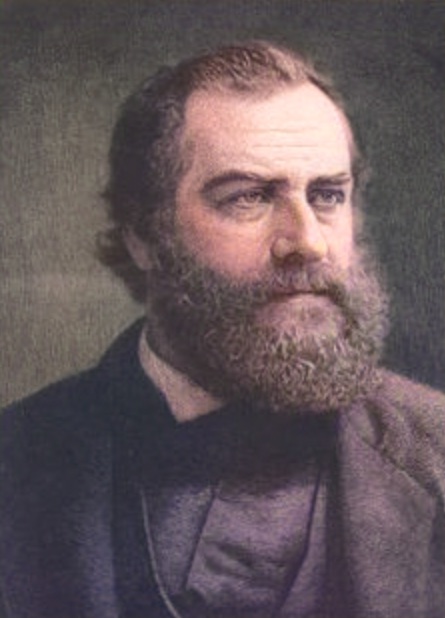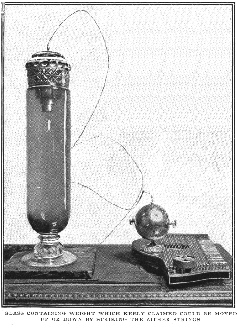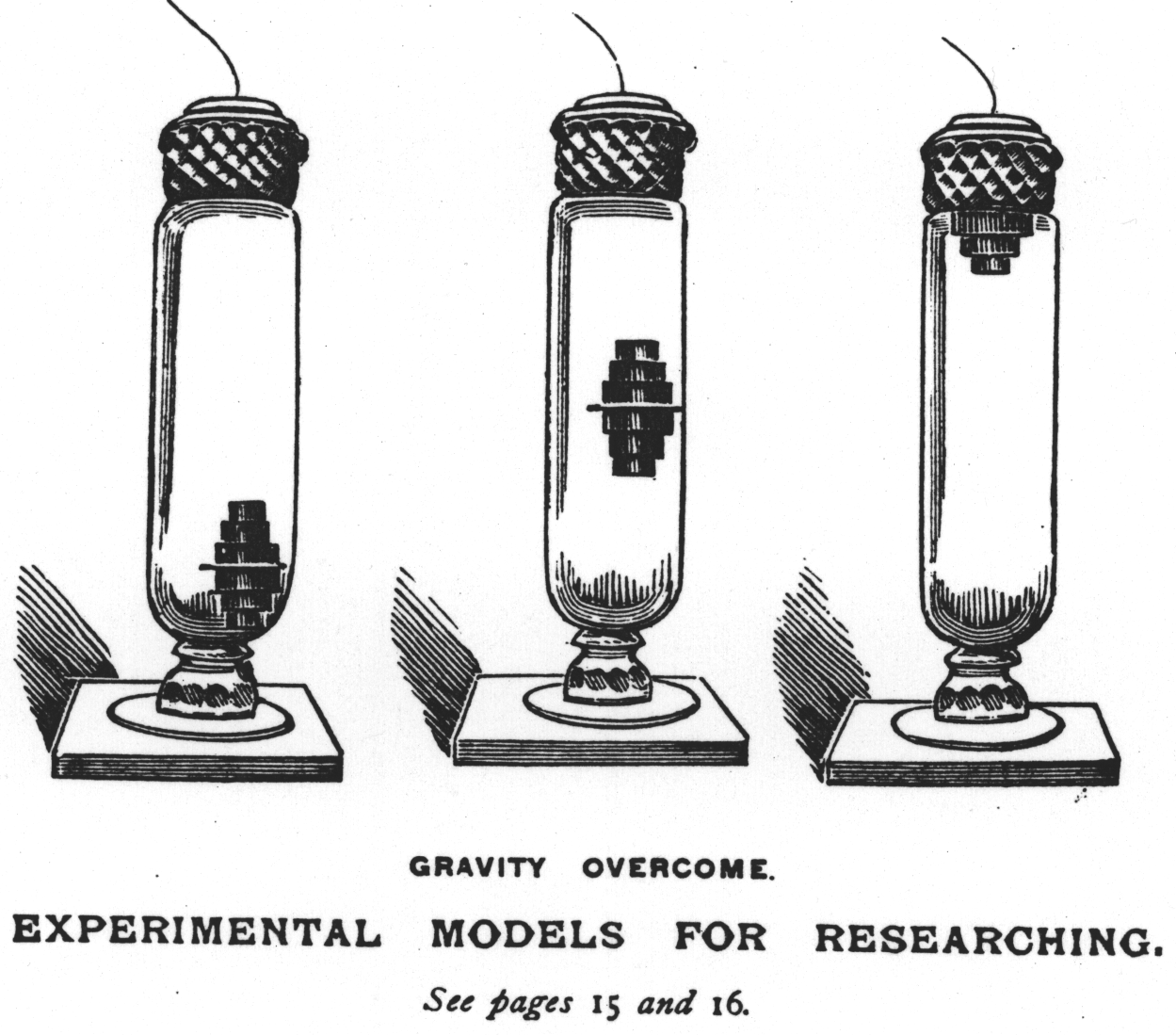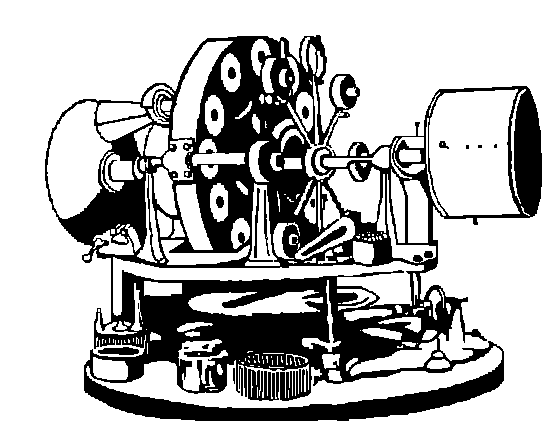See 19.07 - A Modern Wizard The Keely Motor And Its Inventor

ONE of the leading scientists of America, Dr. Joseph Leidy, LL.D. of the University of Pennsylvania, surprised the thinking world in 1889 by coming forward publicly as a supporter of the inventor of the famous "Keely Motor".
Dr. Leidy's published statement was:
"Having had the opportunity of seeing Mr. John Keely's experiments, it has appeared to me that he has command of some unknown force of most wonderful mechanical power."
(Signed) JOSEPH LEIDY.
Coming from a scientist of such repute, these words caused a considerable sensation in both financial and scientific quarters.
A further statement from Dr. Leidy appeared in The Inquirer (Philadelphia) as follows:
April 8th, 1890.
"After having had the opportunity of witnessing a series of experiments made by Mr. John Keely, illustrative of a reputed new motor power, it has appeared to me that he has fairly demonstrated the discovery of a force previously unknown to science. I have no theory to account for the phenomena observed, but I believe Mr. Keely to be honest in his attempt to explain them. His demonstrations appear to indicate great mechanical power, which when applied to appropriate machinery, must supersede all ordinary appliances."
(Signed) JOSEPH LEIDY.
Previous to this announcement, for upwards of twenty years a completely unknown man, John Worrell Keely of Philadelphia, had been working patiently and secretly to demonstrate that he had discovered a new force in nature that would eclipse electricity and all other known mechanical forces.
An extremely big order, all must admit. Keely had been working on his idea long before scientists had begun to discuss the probability of "bursting the atom" to release the enormous force contained in it, which experiment has in recent years been partially carried out by scientists in England, Germany and America during 1932-33.
Keely's principal work for years previous to its becoming talked about, had been his efforts to demonstrate, to put it in his own words "that all corpuscles of matter can be subdivided by certain orders of vibration, thus showing up new elements." It was not however, until by what men call "mere chance" that Macvicar's Sketch of a Philosophy fell into his hands, together with a work entitled [Harmonies of Tones and Colours], written by a Mrs. F. J. Hughes, a niece of Darwin's, that caused him to turn his attention to the structure of ether and he learned that "the same laws which develop harmonies develop the universe."
This recalls to one's mind that beautiful prophetic verse by Coleridge:
"What if all of animated nature
Be but organic harps diversely formed,
That tremble into thought as o'er them sweeps,
Plastic and vast, one intellectual breeze.
At once the soul of each and God of all ?"
From this moment Keely turned his attention to etheric vibration and the flow of the magnetic current of the earth from pole to pole, with the astonishing result that he so perfected a motor to make use of these forces that between 1889 and 1890 he was in a position to show to scientists, in his laboratory in Philadelphia, a machine that ran by some mysterious power, or to quote the words of Dr. Leidy, "he demonstrated the discovery of a force previously unknown to science."
One might have imagined that such an extraordinary discovery would have been hailed by scientists and the press as great a revolution as that caused by the steam engine and later by the production of electricity.
The contrary was, however, the case. Nearly all men of science, with a few exceptions, together with the press, ridiculed the idea as impossible, and did not hesitate to call Keely a charlatan and a fraud. Prejudice against the unfortunate inventor ran so high that whatever financial sources he had became dried up, and for some years he was often reduced to the point of starvation.
Whatever help or encouragement he received during this period came from two women, who perhaps in their intuition, foresaw the possibilities of such a discovery long before it could penetrate the more dense minds of men.
One of these ladies, Mrs. Bloomfield Moore of Philadelphia, suffered cruelly for her loyalty and generosity to the inventor. Some of her relations attempted in the Courts to prove her insane. An injunction was obtained against her making use of her property, and she was in the end reduced to almost a state of complete limitation.
It was at her house in London that I first heard of the "Keely Motor".
Sitting next me at the luncheon table was the well-known scientific engineer, Major J. Ricarde-Seaver, a man well known in London circles who for services rendered in some engineering project had been made a "grandee" of Spain.
The conversation had turned on the prospects of the "Keely Motor," a subject that on account of hostile criticism about the same time in the press was being much discussed.
To the surprise of everyone present, Major Ricarde Seaver said:
"I have only heard of John Keely's discoveries in the press. All projectors of new ideas are at first subjected to calumny, criticism and ridicule. James Watts, the inventor of the steam engine, took over thirty years to develop his plans. In the meantime he was often laughed at.
"When the idea was first mooted of running an electric cable to America, it was considered absurd. It is the same with many other inventions that in the end prove of use and benefit to humanity.
"Judging from articles I have read, Mr. Keely has demonstrated to many eminent men his neutralizing or overcoming of the law of gravity and the separation of metallic plates by a new means of employing the Law of Vibration. Such men as Dr. Joseph Leidy of the University of Philadelphia and Dr. James M. Wilcox, the author of "Elemental Philosophy" have testified that they have witnessed Keely's experiments and were satisfied that he has made manifest the existence of some, up to now, unknown power that cannot be explained by ordinary physical laws.
"The opinions of such men cannot be lightly thrown aside. I only wish that the opportunity may some day come my way to be sent to Philadelphia to investigate Keely's discoveries myself."
As Major Seaver had only met Mrs. Bloomfield-Moore for the first time that day, he was later surprised to hear that our hostess had for years been deeply interested in the progress of the "Keely Motor".
Six months later, Major Seaver dropped in to see me in my rooms in New York City.
"Yes," he said, as he held out his hand, "my wish became realized. Barnato Brothers, the firm to which I am advisory engineer, have sent me over to investigate and report on the 'Keely Motor.' I am going to Philadelphia tomorrow and I propose that you come with me. Give yourself a holiday for a few days and come along."
The next day found Major Seaver and myself on the train together.
During the journey I got the Major to tell me something of his plans.
"I have no preconceived ideas about Keely, one way or the other," he said. "I am just going with an open mind commissioned to report to my employers if there is any commercial possibilities in his 'Motor.' Its supposed weak point is, that it can only be set in motion by Keely striking a chord of vibration on a violin, which is the key to unlock a similiar vibration in the machine. If this is really the case, then a man of Keely's attainments may any day invent an instrument to take the place of the violin, and if such a thing should happen, it would be worth while for such a firm as Barnato Brothers to pay many millions of pounds to have an interest in such an epoch-making discovery."
The next morning Major Seaver presented his credentials at Keely's workshop.
The inventor received us without any formality. He was in fact in his shirt-sleeves and did not even make a pretence of putting on his coat. He was a most unassuming man, very simple and direct in his words and expressions.
He had no pretensions of being taken for an engineer or a scientist or anything out of the way.
In answer to one of Major Seaver's questions as to what had first led him to believe that an, up to then, unknown force existed beyond the power of steam and electricity, he very simply said, "The idea came into my mind from where I cannot tell. Perhaps it first came from a craze I had to study the magnet to attempt to solve what the mysterious power was that enabled it to attract steel and iron to itself.
"For a long time I wondered over the indisputable fact that a horseshoe of iron could be magnetized in a few seconds by the current of a few amperes from a battery, and that such a magnet could lift many pounds weight of metal. Further, that every second of time without end while the magnet is expanding energy it totals up an almost inconceivable amount of actual power, not alone that, but the magnet of one pound lifting power today, may and in fact will be stronger tomorrow.
"Where does this really tremendous amount of energy come from? By what inscrutable process does the mere magnetization of a bar of iron make of it a machine for the transformation of energy, even more, a perpetual creator of force?
"It came into my mind that there was a hidden process going on of some kind, energy going into the magnet and flowing out of it all the time it was doing work energy in some form.
"Where did it come from "” gravity? atmosphere? solar rays? earth currents? Who can say?
"The mere fact of the magnet carrying its load proves conclusively the constant flow or positive action of a sympathetic force, the velocity exceeding millions of vibrations per second.
"In the course of many years of experiments, I believe I have discovered a means of harnessing what may be called 'etheric' force and of overcoming gravity.
"I want you, Sir," Keely went on, turning to Major Seaver, "to examine my machines from the standpoint of the sceptic. Calumny has asserted that I have them connected by a hollow steel wire by which I employ compressed air.
"I want you to satisfy yourself especially on this point. You are entitled to lift the motor off the bench, to place it where you like and it will still function.
"The first demonstration I will give you is that of starting the motor by a note of music, otherwise vibration. I want you to do this yourself. You will take this violin, pass the bow across the strings. At first you may not succeed, but you will eventually."
Major Seaver took the violin. He was fully ten feet away from the machine he was supposed to start. For fully five minutes he tried note after note, but nothing happened. He handed the violin over to Keely.
Perhaps it was due to his long years of practice, or it may have been owing to his unusually keen musical hearing, but the fact remained that in one stroke of the bow an immediate response was heard in the machine. The buzz from it grew louder every second until its speed became so great that, although bolted firmly on the bench, it rocked the whole place.
"Can you stop it?" Major Seaver asked. For answer Keely drew a discordant note from the violin. The machine immediately began to slow down and finally stopped.
"Now, Major," Keely said, "you should be able to start it up yourself. Be patient, try tone after tone and chord after chord. Sooner or later you must strike the right one."
Major Seaver, with a very patient look on his face, again took the violin. This time he drew longer notes from the instrument. Suddenly an answering buzz was heard in the machine. It started off as before, its speed rapidly increasing every moment.
Again the Major lifted the violin. He drew a sharp discord from the strings. Instantly the motor slowed down and became silent again.
"Remarkable," was all Seaver said. Then, taking up a wrench lying near at hand, he very deliberately undid the bolts and lifted the motor off the bench.
As no connecting wires of any kind were to be seen he rebolted the machine and handing me the violin, told me to try.
Perhaps it was what is called "beginners' luck." I had barely drawn a sharp clear note from the "A" string, when again the motor started.
This time the "stopping" was the difficult part. Though I struck discord after discord, still the motor went on rapidly increasing its velocity. I appealed to Keely to help me. He took the violin, struck one discord and immediately the motor slowed down and stopped as before.
"That is the one weak point that up to now prevents its commercial value," Keely said. "My efforts now are being concentrated to make an instrument that will give off an exact note to start and stop the machine at will. The difficulty is not an easy one to get over owing to the variation in the magnetic and etheric currents which are changing continually, but I believe that one of these days I will get the inspiration how to solve the problem."
Keely next showed us his revolving globe of glass that had caused much comment in hostile newspapers.
It was of very simple construction, merely a large glass globe balanced on a pivot of platinum that, when spinning, kept its equilibrium by centrifugal action exactly as a boy's top keeps itself in position by the same law.
This globe was also started by a vibration from the violin. When it had attained considerable velocity, Keely made me lift it off the table and carry the whole thing, wooden stand and all, several times round the room. As its revolutions became more and more rapid I grew alarmed, believing it might any moment fly to pieces. Again a discord from the violin and in a few minutes it stopped.
The next day Keely showed Major Seaver and myself another of his inventions equally startling. It was nothing more or less than a means of overcoming the law of gravitation as applied to airships.
Before going into this demonstration the inventor showed us a remarkable experiment in connection with this idea.
Three glass chambers, forty inches in height, filled with water, were placed on a slab of glass. In each of these cylinders were three metal spheres weighing six ounces each. When a wire composed of silver and platina connected these glass chambers with the sympathic transmitter, the metal spheres rose or descended in them or remained stationary at any point with a motion as gentle as that of a thistledown floating in air.

See Also
Acoustic Levitation
Aerial Navigation
air-ship
Figure 17.18 - Keelys Levitation Demonstration
Gravitation
Levitation
Pittsburg Dispatch April 07-1890

See Also
17.20 - Acoustic Levitation
Acoustic Levitation
aerial navigator
aerial navigation
Air-ship
Air-ship model
Figure 17.18 - Keelys Levitation Demonstration
Figure 19.15 - Keelys Levitation Experiment
Gravism
Gravity
Keelys Aerial Navigation
Latent Force and Theory of Vibratory Lift for Airships
Levitation
weight
In demonstrating what appeared to be the overcoming of gravity for aerial navigation, Mr. Keely next showed us a model of an air-ship weighing about eight pounds. When the differential wire was attached to it, it also rose floated, or remained stationary, at whatever height he wished it to be.

This remarkable demonstration of this model air-ship, it must be remembered, was shown us at the Keely Laboratories in 1890, some thirteen years before the brothers, Orville and Wilbur Wright, flew the first aeroplane in (Carolina in 1903 and the Brazilian Dumont flew) in France in 1906.
Keely allowed Major Seaver to make, without hindrance or opposition, whatever investigations he wished. The Major in the end freely confessed that he could find no evidence of "hollow wires," compressed air or electric power used in any way in Keely's demonstrations. (See Eye Witness Accounts)
As we returned to New York on the train the next day he summed up his meeting with the inventor by saying: "I can only come to the same conclusion as Professor Leidy and Dr. J. M. Wilcox 'that Keely has command of some unknown force of most wonderful mechanical power.'"
In spite of this, this really great inventor, or as Keely preferred to be called, "discoverer," was no nearer to financial success than before. Major Seaver had to report to his company, Barnato Brothers of London, that until the moment arrived when Keely produced a mechanical device to take the place of his violin there could be no prospect of success of "the Keely Motor," from a commercial point of view.
And so things went on until Mrs. Bloomfield Moore, under opposition from her family, could no longer remain as Keely's backer. Bills and writs for money came pouring in on the inventor's head, the press lost patience, papers denounced "the Keely Motor" as a failure and Keely as "one of the greatest swindlers that ever lived." See Was Keely a Fraud?
Perhaps it is that inventors, like poets, painters and writers, belong to an unusually sensitive class. They can only create by being encouraged in their visions and dreams.
So few realize that "dreams" have been so often the forerunners of reality that it is to "dreamers" that the world owes so much. Poor Keely became literally hounded to death by the press, under-paid reporters in search of copy made "wonderful revelations," editors in easy chairs wrote sarcastic comments.
"Man's inhumanity to man" crushed one more over-sensitive soul, and so a great discovery became lost, at least for the time being.
Alone, one night in the winter of 1898, after destroying all his papers, the records of over twenty years research, together with his machines, John Worrell Keely put an end to his own life. (See Chronology for the various obituaries.)
- * * * *
Copy of final report of the investigations of W. Lascelles-Scott of the Physical and Chemical Laboratories, Forest Gate, England.
May 1st, 1896.
"From a lengthened personal examination of Mr. Keely's appliances, I am distinctly of the opinion that he has discovered a force hitherto absolutely unknown to science, and that he holds within his grasp a driving power, or means of performing mechanical work, which might be called illimitable."
(Signed) W. Lascelles-Scott.
See Also
3.05 - Two Principles
Air-ship
Atlin
Atlin Project
Chronology
Dynasphere
Etheric Liberator used with Atlin the Musical Dynasphere
Gravity
Induction
Levitation
Mind The One Universal Substance
Musical Dynasphere
Part 20 - Musical Dynasphere - Current Research
Roots of the Vibratory Etheric Tree - Keely's Musical Dynasphere
Sympathetic Induction
Was Keely a Fraud
